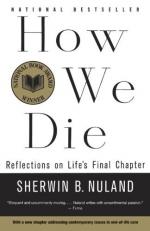
|
| Name: _________________________ | Period: ___________________ |
This test consists of 5 multiple choice questions, 5 short answer questions, and 10 short essay questions.
Multiple Choice Questions
1. How did Katie Mason die, according to the author in Chapter 6?
(a) She had an aneurysm.
(b) She was murdered.
(c) She had cancer.
(d) She had AIDS.
2. How old was James McCarty when he was admitted to the university hospital where Dr. Nuland worked?
(a) 52.
(b) 35.
(c) 18.
(d) 43.
3. The human heart has a mass between how many grams?
(a) 425-500.
(b) 80-120.
(c) 650-750.
(d) 250-350.
4. What does the character of Horace Giddens suffer from?
(a) Chronic heart disease.
(b) Exsanguination.
(c) AIDS.
(d) Alzheimer’s Disease.
5. Dr. Nuland theorizes that 85% of the aging population will die from one of seven primary causes, which he refers to as what in Chapter 4?
(a) The seven doors to the afterlife.
(b) The seven knives of doom.
(c) The Grim Reaper’s seven sons.
(d) The seven horsemen of death.
Short Answer Questions
1. Dr. Nuland relates that cardiac events are what, if discovered soon enough in Chapter 1?
2. What word from Chapter 6 refers to the iron-containing oxygen-transport metalloprotein in the red blood cells of humans?
3. Where do Sherwin B. Nuland, M.D. and his family currently live, according to the Introduction?
4. At the time the book was written, Dr. Nuland claimed that nearly how many Americans would die every day of ischemia?
5. In examining the “Near-Death Experience” in Chapter 6, Dr. Nuland presents statistics from the case studies of what psychologist?
Short Essay Questions
1. What medical progress has been made in the diagnosis and treatment of Alzheimer’s disease, according to the author in Chapter 5?
2. How does the author describe the progression of Alzheimer’s in Chapter 5?
3. What does the author write of the “mystery” and “myth” of death in the Introduction?
4. How does the author go about explaining the heart’s functions in Chapter 2?
5. How are heart problems and heart disease diagnosed and predicted, according to the author in Chapter 2?
6. What are the processes universal to dying described by the author in his Introduction?
7. What does Dr. Nuland suggest as the cause for the sense of peace that describes certain individuals who die through severe trauma in Chapter 6?
8. How treatable are cardiac events, according to the author in Chapter 1?
9. How do the brain and heart change as a person ages, according to the author in Chapter 3?
10. What case study does the author cite in discussing death by murder in Chapter 6? How did this individual die?
|
This section contains 859 words (approx. 3 pages at 300 words per page) |

|




